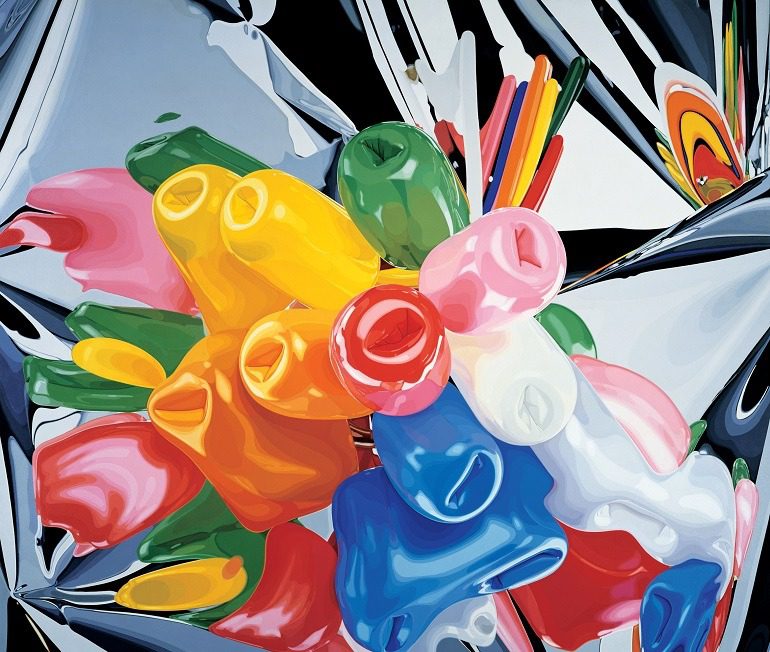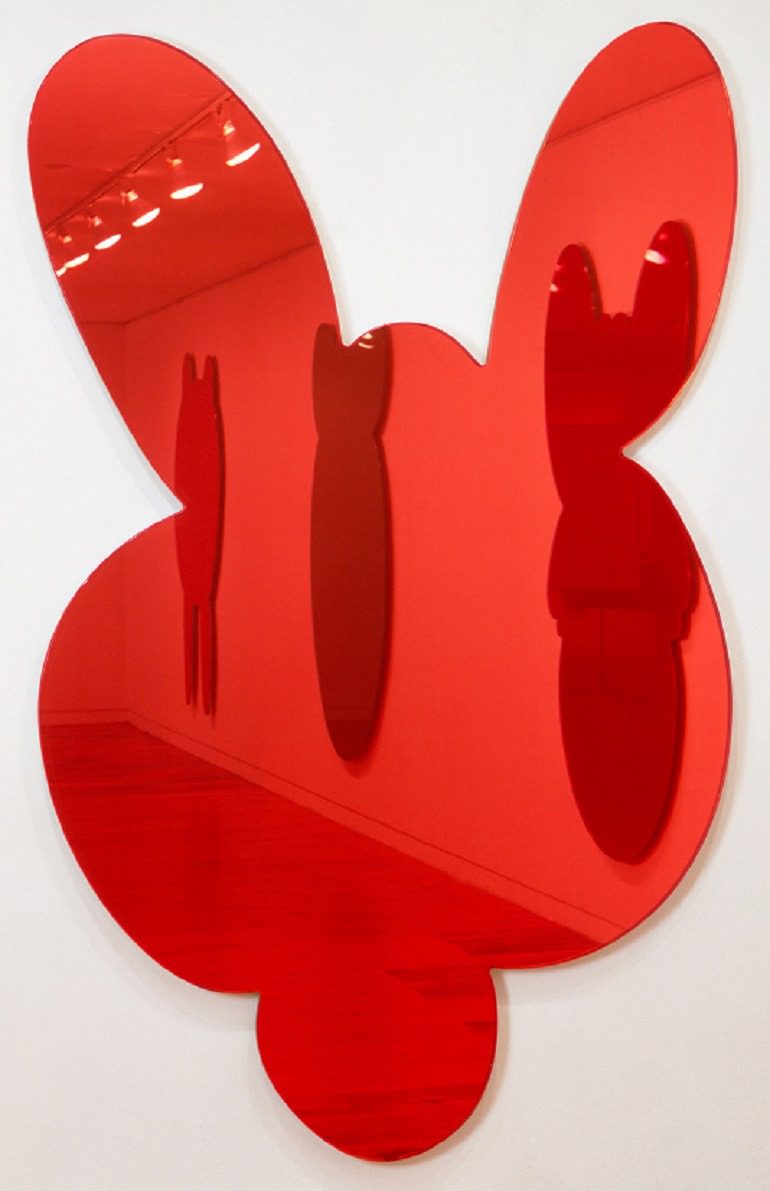ART & DESIGN
Michael Jackson and Bubbles is one of Jeff Koons art in the retrospective of his works at the Whitney. The 1988 piece is Porcelain and measures 42 x 70 1⁄2 x 32 1⁄2 in. Private collection. © Jeff Koons. Image courtesy of Whitney Museum of American Art
ART REVIEW: Jeff Koons: A Retrospective at the Whitney Museum of American Art rekindles old controversies about Jeff Koons art and artistic career
BY KAZAD

Jeff Koons, Tulips, 1995 – 98. Oil on canvas; 111 3⁄8 x 131 in. Private collection. © Jeff Koons. Image courtesy of Whitney Museum of American Art
NEW YORK, NY., —Presently at the Whitney Museum of American Art in New York is Jeff Koons: A Retrospective. Curated by Scott Rothkopf, the Whitney’s Associate Director of Programs, the brilliantly installed exhibition chronicles the artistic career of this very important and controversial American artist. Jeff Koons: A Retrospective is the last show in the Marcel Breuer building which will soon be taken over by the Metropolitan Museum of Art. Perhaps this is why all effort was made to make this show memorable.
Jeff Koons Art Retrospective
Jeff Koons: A Retrospective is the Whitney Museum of American Art’s largest survey devoted to a single artist. It occupies nearly the entirety of Whitney’s Marcel Breuer building and every space is filled with works of the artist spanning over 36 years. The show opens with a section filled with works from the series called The New. The New consists of gleaming cylindrical vacuum cleaners encased in Plexiglas and suffused with an insistent glow.
Obsessive Compulsion
Around the cylindrical vacuums are pairs of other everyday appliances resting on pedestals of fluorescent lights bright enough to be disconcerting. At first instance, these works reference domesticity and hygiene. The New Shop-Vac Wet/Dry, for instance, is essentially a machine used for cleaning. However, for Koons, these appliances hold a deeper meaning. They reference our obsessive compulsion for something new and the effort of manufactures of these products to exploit that desire by developing captivating mode of advertisement to intensify that passion. Created in the 1980s, the works, a cross between minimalism, pop, and conceptual art were first exhibited at the New Museum of Contemporary Art, New York in1980. They soon became the instant subject of controversy as many art lovers wondered if they qualify as art.
That query continues to resonate in this exhibition. A case in point is Play-Doh, a colorful sculpture mimetic of the play-doh children play with. According to Koons, the idea for the sculpture started more than 20 years. While visiting with his son in Italy, he noticed that he was playing with a pile of colorful play-doh which he piled on each other. That gave him a great idea for a fantastic sculpture. While Play-Doh is not a replica of what his son created, it was the main source of influence. This piece dated 1994-2014 is perhaps one of the best works in the show. Just like many of his other works, the idea went through a long gestation period.
Jeff Koons Banality
On the third floor is Banality, a series that borrows from pop culture and eulogizes celebrity worship. Occupying a long narrow gallery is a row of 10 figures in polychrome wood or porcelain. One of the fascinating pieces in this section is the now-famous rendition of American pop star Michael Jackson and his pet chimpanzee, Bubbles sitting on his lap. Years after it was created, the work continues to amaze art lovers.
It was fascinating watching people’s reactions as they work around the sculpture. Perhaps they were pondering what to do with these pieces that celebrate this great American Idol. This poignant porcelain rendition of Michael Jackson and Bubbles dressed in gold and white apparel is not only ostentatious but also mystifying. A pig flanked by two angels and a tracksuited boy is another noteworthy piece in this section. In this sculpture in the round, three angels urge and push a rather well-fed pig with a green ribbon around its neck. While the intention of the angels and the boy remains a mystery, it is clear that getting the pig to its destination is a daunting task.
London Bobby
Bear and Policeman 1988 presents a London bobby befriending a goofy bear armed with a larger than life whistle. This is another of Koons works that have made many questions his authenticity as an artist, and wonder if he is just a creator of tasteless objects. Is London bobby befriending a goofy bear an attempt at commodification or is it art? That is a question many pondered standing in front of these sculptures. Also in this space is Pink Panther, a sculpture of a half-nude woman carrying an ecstatic pink panther. Pink Panther is filled with sexual innuendos.
There are many pieces with sexual allusion and outright depiction of sex in this exhibition. The disconcerting sex pictures and sculptures from his Made in Heaven series of 1989-91 should have been rated “R”. The big paintings printed in oil inks on canvas depict the artist in sexual entanglement with his former wife Ilona Staller, known in her porn-star days as La Cicciolina. In one of the pieces, Koons and his wife dressed in a white seductive negligee engage in a sexual orgy right there on the painting. While the piece, which is as big as a billboard, points to the commodification of sex as seen in many advertisements, Koons sincere look and genuine comfort of his wife gives the painting a lot of credence, eliminating the shame associated with sex.
Childhood Experiences
The fourth floor has a collection of works focused on Children’s toys and antiques. Many of the works in this section are reminders of childhood experiences and regurgitation of the cultural past. This section includes works like Play-Doh, Hulk (Organ), Dogpool (Panties), and Balloon Dog (Yellow). Also included in this section is Balloon Venus (Orange), and an unusual voluptuous geometry representation inspired by the Venus of Willendorf. Liberty Bell is one of the new works in this section. An exact replica of the one in Philadelphia that Mr. Koons visited as a child, the bell which took about ten years to create (2006-14), must have left many wondering what it is all about beyond usurping the aura of the original.
ART REVIEW | READ ALSO: 70 Zebra Finches Create Melodic and Ambient Music at the Peabody Essex Museum
While many of the works in this exhibition continue to engender a lot of questions, what is not in doubt is the outstanding curatorial ability of Mr. Rothkopf who presented an eloquent narrative of Koons artistic career. The curatorial approach of this exhibition is not just to showcase Koons’s work through the years, but also to present the progression of his creative career. Arranged chronologically, the exhibition occupies five of the museum’s six floors. For easy navigation and understanding of Koons creative endeavors through the years, Mr. Rothkopf situates one series to a gallery. The journey leads viewers from Koons incursion into ready-mades, like the vacuum cleaners; to the appropriation of found objects cast in bronze and his famous balloon sculpture finished in mirror-polished stainless steel.
Jeff Koons Controversy
Jeff Koons: A Retrospective is a show many will remember for a very long time. Besides the grandness and brilliance of the curator, the narrative brings to bear the controversy that continues to follow Jeff Koons and his work. It has also rekindled some of the very old questions of if Koons can be considered an artist or a creator of commodities labeled art. There is also the question of why his works are so expensive. While critics continue to debate where to situate Koons and his art, what is very clear from the Whitney Museum of American Art show is that this is an artist who is unafraid of pushing boundaries. His conjectures and vocabulary of art straddle un-established thresholds invisible to many. Perhaps that is why many continue to define him as a great American artist.

Jeff Koons, Balloon Dog (Yellow), 1994 – 2000. Mirror-polished stainless steel with transparent color coating; 121 x 143 x 45 in. . Private collection. © Jeff Koons. Image courtesy of Whitney Museum of American Art

Jeff Koons, Kangaroo (Red), 1999. Crystal glass, mirrored glass, carbon fiber, foam, colored plastic interlayer, and stainless steel; 92 x 59 x 1 1⁄2 in. Private collection; courtesy Sonnabend Gallery, New York. © Jeff Koons. Image courtesy of Whitney Museum of American Art

Jeff Koons, Poodle, 1991. Polychromed wood; 23 x 39 1⁄2 x 20 1⁄2 in. Whitney Museum of American Art, New York. © Jeff Koons. Image courtesy of Whitney Museum of American Art
